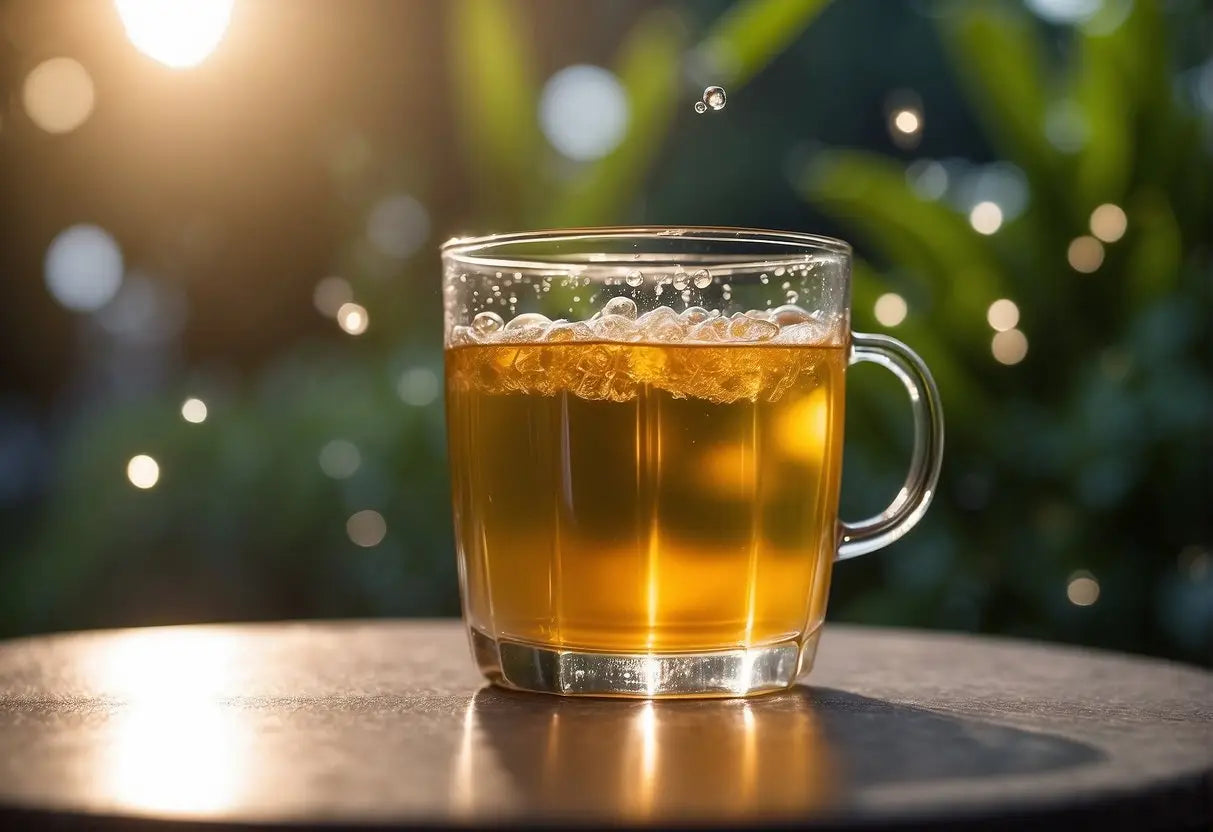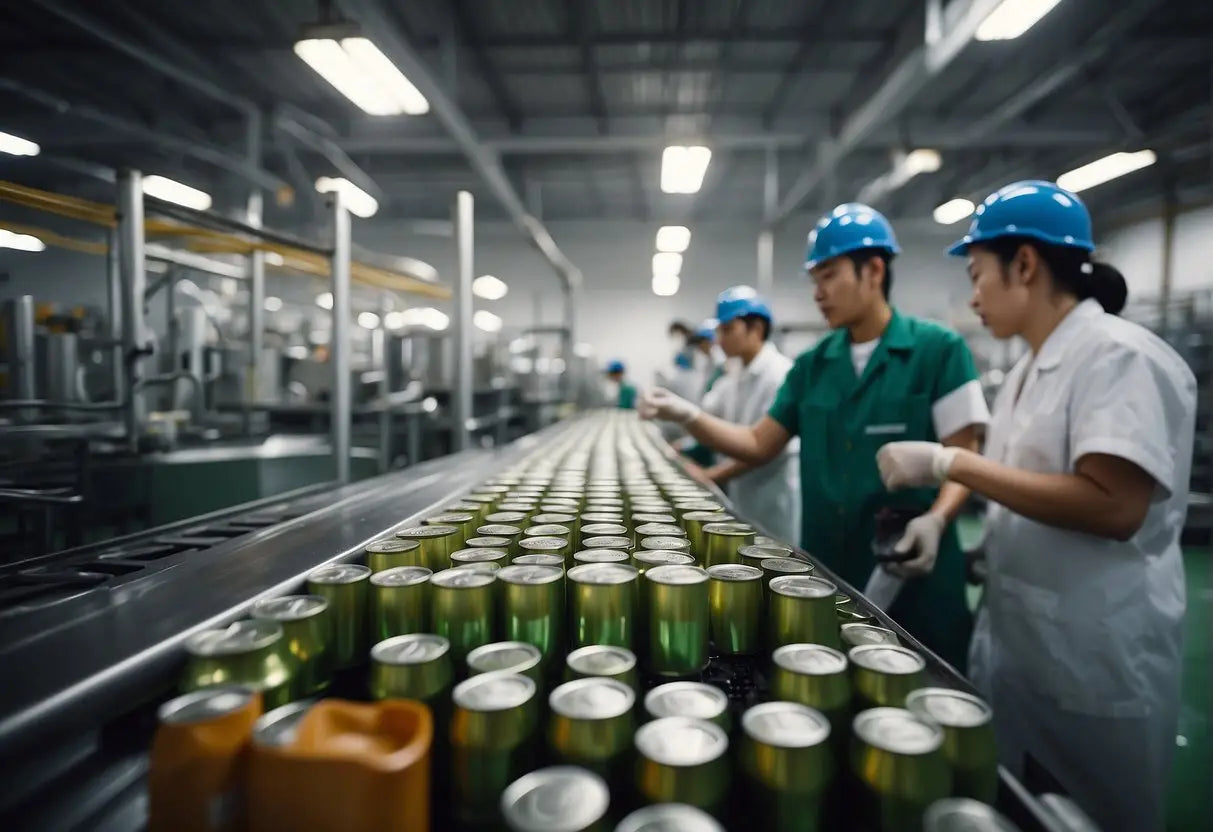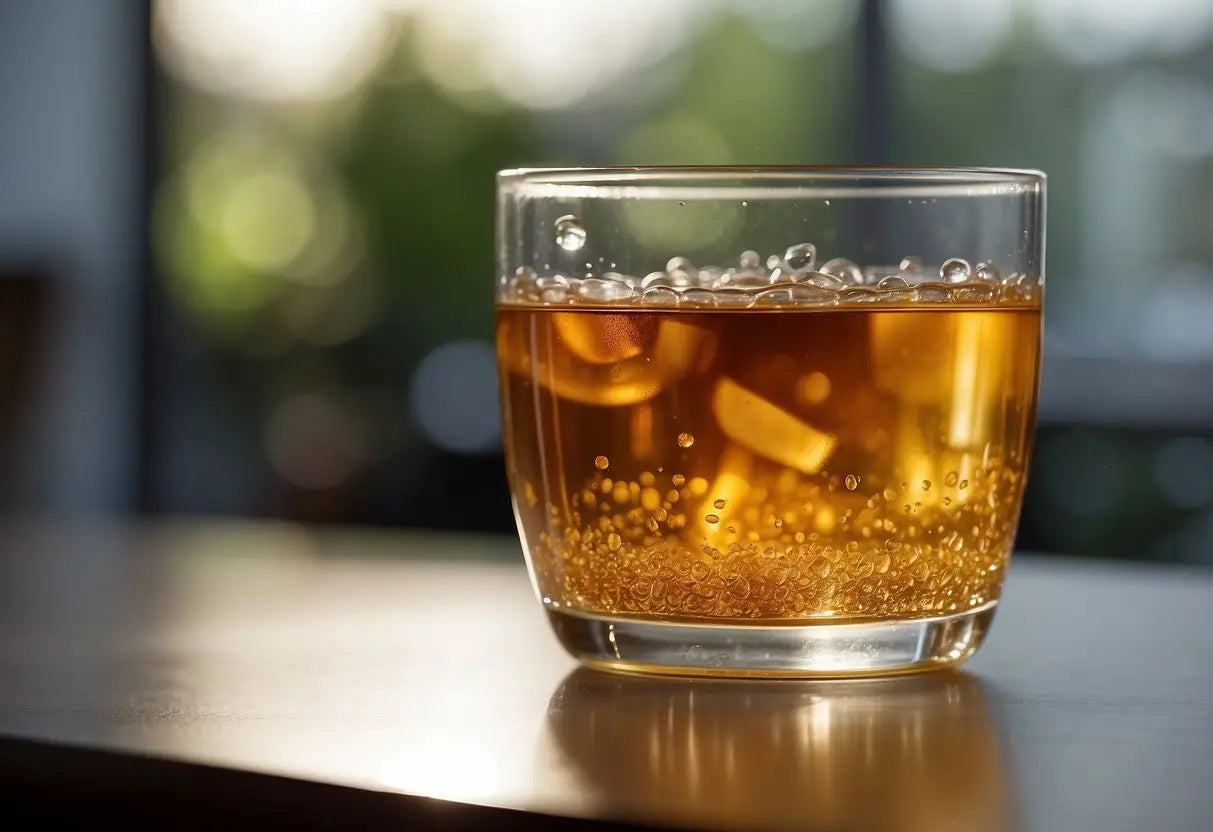Carbonated Tea
Carbonated tea combines the traditional flavors of brewed tea with the fizzy sensation typically found in carbonated beverages. By infusing tea with carbon dioxide gas under pressure, you experience a unique and refreshing drink that offers a twist on classic tea varieties. There are several methods to carbonate tea, including using a soda siphon or a carbonation machine.
When you choose carbonated tea, you have a range of options:
- Types of Tea: Any tea can be carbonated, from green to black, herbal to fruit-infused.
- Flavor Additions: Consider adding fruit syrups, herbs, or spices to enhance the flavor profile.
- Caffeine Content: Depending on the tea base, your drink can be caffeinated or caffeine-free.
Benefits and Popularity
This beverage has gained popularity for its potential benefits:
Bestsellers
- Hydration: Like non-carbonated tea, it can contribute to your daily fluid intake.
- Low-Calorie Alternative: Often lower in calories compared to traditional soft drinks.
Considerations
- Storage: Carbonated tea should be consumed soon after carbonation to maintain its effervescence.
- Serving: Serve cold to maximize the refreshing quality.
History of Carbonated Tea
Your discovery of carbonated tea involves understanding its recent history. The concept of carbonated tea emerged in the late 20th century, parallel to the rise in popularity of carbonated soft drinks. Businesses sought new products that blended traditional beverages with the novel appeal of effervescence.
By the early 21st century, innovators began experimenting with adding carbonation to tea. These early versions were largely artisanal concoctions, crafted in small batches by boutique beverage makers, often focusing on natural ingredients and traditional brewing methods.
In the mid-2010s, commercial interest increased, leading to a range of commercially produced carbonated teas hitting the market. Companies like Sound and BOS brands led the way, offering sparkling alternatives to sugary sodas, with green, black, and herbal tea bases.
Key Milestones in the Evolution of Carbonated Tea:
- Late 20th century: Birth of the idea, influenced by the popularity of carbonated drinks.
- Early 2000s: Small-scale production, focus on artisanal and craft methods.
- 2010s: Increased commercial production, introduction of brands dedicated to carbonated tea.
Your understanding of carbonated tea's history should acknowledge its status as a niche product that has gradually found its place within the wider beverage market. It represents a merging of traditional refreshment with modern tastes for sparkling drinks.
Production Process
The production of carbonated tea involves precise selection and preparation of tea, innovative carbonation methods, custom flavoring and sweetening, followed by meticulous packaging.
Tea Selection
When selecting tea for carbonation, your choice determines the beverage's base flavor profile. Opt for high-quality leaves such as Assam for a malty taste or Sencha for a more grassy note. You should consider the following factors:
- Leaf Quality: Choose full-leaf varieties for a more complex taste.
- Origin: This affects the flavor; for instance, Chinese teas are different from Indian teas.
Carbonation Techniques
The carbonation process involves infusing tea with carbon dioxide (CO2) under pressure to create effervescence. Here's a common method:
- Cold Carbonation: Cooler temperatures help CO2 dissolve better, ensuring your tea remains fizzy for longer.
Flavoring and Sweetening
You may enhance the taste of your carbonated tea with natural flavors and sweeteners. Utilize ingredients such as:
- Natural Extracts: lemon, peach, or ginger for a subtle profile.
- Sweeteners: honey, agave, or sugar; adjust to your preference.
Packaging
The final step is crucial in maintaining the quality and carbonation of your tea. For optimal freshness:
- Containers: Use airtight bottles or cans.
- Preservation: These should be capable of withstanding pressure and preserving carbonation.
Remember to store the final product in a cool, dry place away from direct sunlight.
Health and Safety Standards

Lao Ban Zhang
When choosing carbonated tea, your primary concern should be the health and safety standards adhered to during its production. The beverage should comply with the Food and Drug Administration (FDA) regulations, ensuring it is safe for consumption.
Check for the following specifics to guarantee safety:
- Labeling Accuracy: Ensure that ingredients listed are clear and accurate.
- Caloric Content: Carbonated teas may have added sugars; be aware of the calorie count per serving.
- Caffeine Levels: Be mindful of your caffeine intake, as some carbonated teas can be high in caffeine.
Manufacturers must follow Good Manufacturing Practices (GMP) to prevent contamination:
- Equipment must be regularly sanitized.
- Workers should follow strict hygiene protocols.
To assess quality, consider:
- Expiration Date: Always check for freshness.
- Certifications: Look for certifications like USDA Organic or Non-GMO Project Verified if these are important to you.
It's essential for consumers to report any adverse health effects to the FDA's MedWatch program to facilitate prompt action when required. Remember to stay informed about recalls and safety alerts related to carbonated tea products.
| Aspect | Why It's Important |
|---|---|
| Labeling Accuracy | Ensures you know exactly what you're consuming. |
| GMP Compliance | Reduces risk of contamination. |
| Report Adversities | Helps improve product safety for everyone. |
By keeping these standards in mind, you can confidently select a carbonated tea that aligns with your health priorities.
Types of Carbonated Tea

Carbonated tea is an innovative twist on traditional tea, infusing it with bubbles for a fizzy experience. There are several types to choose from, each offering unique flavors and sensations.
Sparkling Iced Tea: This is your classic iced tea with a fizzy kick. It’s typically sweetened and comes in various flavors such as lemon, peach, or raspberry.
- Plain Sparkling Tea: For purists who enjoy the fizz without extra flavors or sweeteners.
- Flavored Sparkling Tea: Adding a burst of fruit or herbs can enhance the base tea taste.
Kombucha: A fermented tea full of probiotics, it has a natural effervescence. Kombucha comes in a range of flavors from original to exotic fruit blends.
- Home-Brewed Kombucha: You can find starter kits to make your own fizzy fermented drink.
- Commercial Kombucha: Professionally brewed with controlled fermentation for consistent quality.
Matcha Sparkling Tea: A modern take on the traditional Japanese matcha, combining the earthy green tea powder with carbonation.
| Type | Description | Key Flavors/Features |
|---|---|---|
| Sparkling Herbal Tea | Carbonated herbal infusions | Mint, chamomile, hibiscus, etc. |
| Carbonated Tea Energy Drinks | Tea-based energy drinks with carbonation | Added caffeine or natural energizers, various fruit flavors |
| DIY Carbonated Tea | Homemade with a soda maker or siphon | Customizable flavors and sweetness levels |
Whether you choose a canned sparkling black tea or brew a fizzy green tea at home, carbonated tea offers an effervescent twist to your beverage repertoire.
Market Trends
The carbonated tea market is experiencing a significant transformation influenced by evolving consumer tastes, diverse sales channels, and the introduction of innovative products.
Consumer Preferences
Your preferences are increasingly leaning towards healthier and novel beverage options. Carbonated tea, with its perceived health benefits and unique taste, is gaining popularity, especially among younger demographics. Organic and sugar-free varieties are seeing a higher demand, reflecting your growing health consciousness.
- Popular flavors: Peach, Lemon, Berry
- Preferred attributes: Low-calorie, Natural ingredients
Sales Channels
Your shopping habits are shaping the way carbonated tea is sold. Online platforms have shown a considerable increase in sales due to their convenience and wide product range. Meanwhile, traditional brick and mortar stores are still prominent for impulse buys and immediacy.
| Sales Channel | Description |
|---|---|
| Online | Expanded reach, 24/7 availability |
| Supermarkets | One-stop shop, instant gratification |
| Specialty Stores | Curated selections, premium options |
Innovation and New Products
Your demand for innovation has led to a surge in new carbonated tea products. Manufacturers are implementing cutting-edge technologies to enhance flavor and prolong shelf life, ensuring that you receive high-quality beverages.
- Recent launches: Kombucha-infused sparkling tea, Nitrogen-infused cold brew tea
- Packaging innovations: Biodegradable cans, resealable bottles
Regulations and Compliance

When you enter the market with carbonated tea, it is essential that you adhere to the Food Safety and Standards Authority (FSSAI) regulations or the equivalent authority in your country. Here are key compliance factors:
Labeling: Your product must clearly display:
- Ingredients
- Nutritional information
- Expiration date
- Any allergens
- Net quantity
Ingredients Approval: Ensure all additives are approved for use in beverages. For instance, carbon dioxide levels must be within safe consumption limits.
Manufacturing Standards: Your facility must comply with Good Manufacturing Practices (GMP) to ensure product safety and quality.
Health Claims: Any health benefits claimed on your packaging must be supported by scientific evidence and approved by the relevant food and health authority.Please consult the complete guidelines provided by your local regulatory body to ensure full compliance with all relevant food safety and standard regulations. Regular audits and quality checks will help maintain standards and avoid potential penalties or recalls.
Environmental Impact

When evaluating the environmental impact of carbonated tea, it's important to consider various aspects of its production and lifecycle. Here are some key points:
-
Carbon Footprint: The carbonation process requires additional energy, which may increase the carbon footprint compared to non-carbonated tea. The sources of energy used are critical in determining overall emissions.
-
Packaging: Carbonated teas often come in single-use containers, which may contribute to waste. Consider whether these are:
- Recyclable: Glass bottles or aluminum cans.
- Non-recyclable: Certain plastics or composites.
-
Transportation: The further your carbonated tea has to travel from production to shelf, the greater the associated emissions.
-
Water Usage: The production of tea, carbonated or not, typically requires significant water. The sustainability of the water source should be taken into account.
-
Agricultural Practices: Tea plants themselves can offer environmental benefits by absorbing carbon dioxide. Sustainable farming practices ensure these benefits are maximized.
-
Chemical Use: Pesticides and fertilizers used in tea cultivation can have environmental consequences. Organic options potentially reduce this impact.
To minimize your impact, you could:
- Choose products with minimal packaging.
- Opt for locally-produced carbonated tea.
- Look for certifications indicating sustainable practices.
Remember: Your consumer choices can influence manufacturing practices and the environment.
Branding and Marketing Strategy
In launching your carbonated tea product, your strategy must clearly define who your audience is, choose the right channels for advertising, and distinguish your product in the market.
Target Audience
Your target audience is health-conscious consumers ranging from ages 25 to 45. They typically enjoy premium beverages and are willing to pay a bit more for natural, organic ingredients. They prioritize wellness and are often on the lookout for innovative products that offer both health benefits and convenience.
Advertising Channels
To reach your audience, utilize the following channels:
- Social Media: Platforms like Instagram, Twitter, and Facebook allow for targeted ads and influencer partnerships.
- Online Marketing: Invest in search engine optimization (SEO) and Google AdWords campaigns to capture interest at the moment of search.
- Traditional Media: Use selective placements in lifestyle magazines and local radio stations to build brand awareness.
Product Positioning
The positioning of your carbonated tea revolves around three main pillars:
- Unique Flavor Profiles: Emphasize the innovative combination of tea and effervescence that sets your product apart.
- Health Benefits: Highlight the antioxidant properties of tea and the absence of artificial additives.
- Eco-Friendly Packaging: Showcase your commitment to sustainability to resonate with environmentally conscious consumers.
Consumer Usage Scenarios

When you're considering carbonated tea, it lends itself to a variety of scenarios that you might find appealing. First, it's an excellent refresher for those hot summer days when you seek something more intriguing than plain iced tea. It offers a bubbly twist that can invigorate your afternoon slump.
For the health-conscious among you, carbonated tea presents a great alternative to sugary sodas. With fewer calories and a generous dose of antioxidants, depending on the type of tea used, it marries health benefits with the satisfaction of a fizzy beverage.
| Occasion | Benefit |
|---|---|
| After Workouts | Rehydration |
| Midday Pick-Me-Up | Caffeine Boost |
| Social Gatherings | Unique Beverage Choice |
In social settings, carbonated tea could be your go-to drink to serve guests. You might find that its uniqueness makes it a conversation starter. With various flavors ranging from classic black tea to exotic infusions, there's typically a flavor to suit every palate.
Remember, temperature plays a crucial role in your enjoyment. Serve it cold to preserve the carbonation and refreshing taste. If you're on the move, it's easy to find in bottled form, allowing you to enjoy it whenever you desire a fizzy, flavorful boost.
Challenges and Potential Solutions

When considering carbonated tea, you may encounter several challenges:
Flavor Preservation: Carbonation can alter the delicate flavors of tea.
Solution: Employ cold-infusion techniques alongside subtle carbonation to retain the tea's original taste profile.
Shelf Life: Carbonated beverages are prone to quality degradation over time.
Solution: Utilize high-quality packaging materials that limit oxygen exposure, thus extending shelf life.
Consumer Awareness: The concept of carbonated tea is relatively new and might be unfamiliar to many consumers.
Solution: Implement educational marketing strategies to inform potential customers about the benefits and unique qualities of carbonated tea.
Cost of Production: The process of carbonating tea can be more expensive than traditional tea brewing.
Solution: Innovate production methods to reduce costs, and highlight the premium aspect of the product to justify the price.
Health Perceptions: People often associate carbonated beverages with unhealthy choices.
Solution: Clearly communicate the health benefits of tea and the absence of unhealthy additives in your product.
Distribution: Carbonated products require careful handling and storage conditions.
Solution: Establish a reliable distribution network that can maintain the integrity of the product during transit.
Future Outlook
The beverage industry continuously evolves, and your interest in carbonated tea suggests an awareness of this trend. The upcoming years for carbonated tea are promising, with several factors influencing its market trajectory.
Market Expansion: You can expect to see an increase in carbonated tea products as manufacturers respond to the rising consumer demand for healthier fizzy alternatives to sodas.
Innovation in Flavors: Prepare for a broader range of flavors. Traditional teas will fuse with exotic fruits and spices, catering to your adventurous palate.
Health-Conscious Developments:
- Reduced Sugar: You'll see more low-sugar and sugar-free options.
- Functional Ingredients: Added health benefits like vitamins and antioxidants will become standard.
Sustainability Focus: Your environmental concerns drive the market towards eco-friendly packaging solutions. Biodegradable and recyclable materials will likely become prevalent.
Technology in Brewing: Look for advancements in brewing techniques that enhance flavor without adding calories or artificial ingredients.
| Trends | Description | Implications for You |
|---|---|---|
| Customization | Developments in personalized beverages. | More tailor-made options. |
| E-Commerce Growth | Increase in online shopping capabilities. | Convenient purchasing methods. |
| Social Media Influence | Buzz around carbonated tea increases. | Insights into new products. |
Your choices as a consumer will also direct the market, causing producers to fine-tune their carbonated tea offerings. Stay informed, and your preferences will help shape the future of this refreshing fusion of tradition and innovation.
← Older post Newer post →











